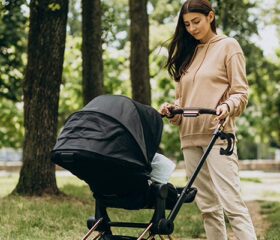Moles on Babies: When They Appear and What They Look Like
It’s normal to find moles on your baby’s skin. Fortunately, they’re usually harmless and don’t need medical attention.

While you might be used to how your own moles look, seeing one on your baby may make you (understandably) more worried. Fortunately, baby moles are rarely dangerous, although they should be monitored.
To put your mind at ease, read on to learn what normal moles on babies look like, when you should be concerned, and how to protect your baby’s skin.
What exactly are moles?
Also known as nevi (a plural term; the singular is nevus), moles are common skin marks that many people have. They’re clusters of melanocytes (pigment cells in the skin). 1
Moles are usually oval or round in shape and pink, tan, or brown in color. They can be flat, raised, smooth, or rough. Sometimes, hair grows from them. You may find moles anywhere on your baby’s (or anyone’s) body. 1
People can be born with moles and can also grow new ones at any time (often when their hormone levels change or after sun exposure), usually up until reaching 40 years of age. As you grow older, your moles’ sizes and shapes may change. They may also darken, fade, or disappear. 2
What’s the difference between moles, birthmarks, and freckles?
As the name suggests, birthmarks typically appear at birth. You may have a birthmark if the blood vessels or pigment cells in a patch of skin didn’t form correctly. 3
Moles, on the other hand, can either occur at birth or develop later in life. They appear due to clusters of pigment cells on your skin.
As for freckles, they’re caused by an overproduction of melanin (the pigment that gives your skin, hair, and eyes their color), which can happen after prolonged sun exposure. 4 Freckles are typically smaller than moles, show up between ages 2 and 4, and are more common in those with lighter skin (although anyone can have moles). 5
Are moles genetic?
Although this hasn’t been widely studied, there are some studies suggesting that your baby’s genetics play a role in how many moles (either benign or cancerous) he has. 2 In fact, benign moles sometimes even appear in the same places on children as they do in their parents.
Are moles on babies dangerous?
Most moles on babies aren’t dangerous. The moles your baby is born with or develops during infancy are called congenital nevi, and they’re usually benign. 2
There’s a small chance that your baby will be born with a very large mole, called a giant congenital melanocytic nevus. Very rarely, melanoma, a type of skin cancer, can develop in this kind of mole. 2
Your baby might develop large moles with irregular shapes and colors as he grows older. These moles, which are called atypical moles or dysplastic nevi, are more prone to developing melanoma. The good news is, they aren’t very common—your baby most likely won’t have them. 2
If you’re worried about your baby’s moles, you can take photos of them at regular intervals to monitor their growth.
When should you worry about moles on your baby?
While moles on babies are typically harmless, it’s still a good idea to keep an eye on them.
The American Academy of Dermatology Association (AAD) has a helpful guide for what to look out for in moles called the ABCDE method: 6
- Asymmetry: It’s cause for concern if the two halves of the mole don’t match each other.
- Border: The same goes if the mole’s edges are irregular, ragged, notched, or blurred.
- Color: The mole has uneven colors or a mix of shades (e.g., bits of brown, black, tan, red, white, or blue).
- Diameter: The mole is close to or bigger than 6 millimeters (similar to the size of a pencil eraser). This is mainly a concern for moles that develop after birth, as some congenital nevi can be bigger than 6 mm to begin with.
- Evolving: The mole doesn’t look the same as it originally did, meaning its size, shape, or color has changed.
If you notice any of the signs above in your baby’s moles, tell your doctor at his next appointment. You should also tell them if any of your baby’s moles bleed or seem itchy or painful.
What can you expect at the doctor’s office?
Your doctor will typically check your baby for atypical moles during his routine well-child visits. Doctors can usually tell if a mole is benign just by looking at its structure with a tool called the dermatoscope. 7
If the doctor suspects there’s something wrong with a mole, they may schedule a biopsy for your child to rule out melanoma. With biopsies, doctors will remove a small piece of tissue from the mole to examine it under a microscope.
If your doctor forgets to examine your baby’s moles during his visit, be sure to remind them. Always let your doctor know about any changes you notice in your baby’s moles.
How to prevent moles and protect your baby’s skin
The main way to protect your baby’s skin from growing more moles or developing cancerous ones is to protect it from the sun. 2
Try to keep your baby indoors when the sun is strongest, usually between 10 AM and 4 PM. 8 When you’re outside, dress your baby in lightweight clothing that will protect him from the sun, like long sleeves, pants, and a wide-brimmed hat.
Even if you dress him in protective clothing, keep your baby out of direct sunlight as much as possible.
Wait until your baby is 6 months old to apply sunscreen
While it’s important to apply sunscreen, the CDC recommends waiting until your baby is over 6 months old to do so. 8 Your baby is more likely to get side effects from sunscreen, such as a rash, than older children or adults are. 9
Can and should you get your baby’s moles removed?
Since moles can become cancerous, if you’re wondering whether you can have your baby’s moles removed, you’re in good company.
However, most pediatric moles do not require removal unless they show concerning features. Your doctor can help determine whether removal is medically necessary.
Be aware that if your doctor does recommend having a mole on your baby removed, the procedure may lead to scarring. 10 Follow your doctor’s advice when it comes to caring for your baby’s skin.
Final thoughts
You generally don’t have to worry if your baby has moles—they’re most likely benign. That said, it’s still a good idea to keep an eye out for any changes in them. If you notice any, report them to your doctor.
Whether your baby has moles or not, protect his skin from the sun. This doesn’t mean you can’t take him outdoors; just pick the right times, dress him properly, and try to stay in the shade. You can keep him safe while having fun on a sunny day!
Article Sources
- MedlinePlus. "Moles" Retrieved August 27, 2025.
- MedlinePlus. "Are moles determined by genetics?" Retrieved August 27, 2025.
- MedlinePlus. "Birthmarks" Retrieved August 27, 2025.
- Cleveland Clinic. "Freckles (Ephelides and Solar Lentigines)" Retrieved August 27, 2025.
- Cleveland Clinic. "Q & A: Freckles and Your Skin" Retrieved August 27, 2025.
- American Academy of Dermatology Association. "What to Look For: Abcdes of Melanoma" Retrieved August 27, 2025.
- Harvard Health Publishing. "Moles (nevi)" Retrieved August 27, 2025.
- Centers for Disease Control and Prevention. "Sun Safety Facts" Retrieved August 27, 2025.
- U.S. Food and Drug Administration. "Should You Put Sunscreen on Infants? Not Usually" Retrieved August 27, 2025.
- Cincinnati Children's. "Moles (Congenital Melanocytic Nevi)" Retrieved August 27, 2025.







